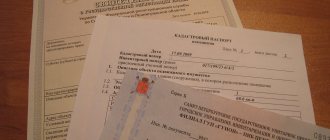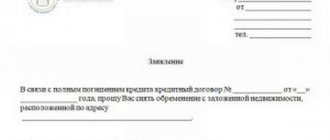General information about encumbrances
First, let’s understand what an encumbrance on a property is. Encumbrance is usually understood as the status of an object in which the administrative or other rights of the owner of the property are limited to one degree or another in the interests of third parties.
As a rule, an encumbrance is a security measure that guarantees the interested party that the owner of the property will fulfill the assumed property obligation. (hereinafter referred to as Federal Law No. 218) provides, in particular, for such types of encumbrances on real estate as:
- mortgage - an apartment is pledged to the bank and cannot be sold without its knowledge (hereinafter referred to as Federal Law No. 102);
- rent - the transfer of ownership of housing obliges the new owner to pay rent payments to the former owner ();
- arrest is a coercive measure that excludes the possibility of alienation of the debtor’s property (hereinafter referred to as Federal Law No. 229);
- lease – obliges the owner to transfer the object for temporary use to a third party ().
It is important to remember when purchasing real estate with an encumbrance that this restriction may have a different composition, nature and legal nature.
Read more about this in the material “What are restrictions on rights and encumbrances on real estate.”
Types of encumbrances
There are five types of encumbrances on an apartment (or any other type of real estate):
- Mortgage: This is the option we described above. The bank places an encumbrance on the property, since it is pledged to it, until the entire debt is repaid (including interest, possibly fines or penalties). After the mortgage is paid, the bank removes the encumbrance and the third party's ownership rights are canceled. But, if for some reason the borrower fails to repay the loan, the bank takes the home. The scheme works similarly if it was not a finished home that was purchased on credit, but a building plot, with a loan to build a house.
- Easement – here restrictions are imposed not by the owner, but by a government agency. Most often, this concept refers to land plots. For example: a vegetable garden and garden owned by Ivanov. But, an easement has been imposed on the garden by the local administration, because it is an important object for laying utilities.
- Under a trust management agreement. Here the owner transfers the right of management to a third party, but without giving him the right of ownership. For example, the owner rents out housing, but remotely, since he himself lives in another country. So that everything is fine with the housing, there is someone to control what happens there, he hires a principal. And to prevent this principal from selling the property under a power of attorney, the owner imposes an encumbrance - a ban on any registration actions without his consent.
- Rent agreement. The apartment is transferred into the ownership of the rent debtor, but only after the owner dies. And while he is alive, the rent debtor must fulfill the conditions of the contract: this may be the maintenance of the rent holder, the payment of a certain amount every month.
- Encumbrance with a guardianship authority. If a minor is a co-owner or full owner, then any legal transactions with housing can be carried out only if the guardianship authority allows it. This type of encumbrance is imposed automatically immediately after the minor receives ownership. This is necessary in order to protect the rights of the child.
- Arrest. This type of encumbrance is imposed by a court decision by the FSSP. The reason may be some kind of debt, or the participation of the apartment in legal proceedings or the division of marital property. For example: a wife, fearing that her husband will sell the apartment while the divorce proceedings are still ongoing, asks the court to impose an encumbrance. The judge issues a writ of execution, according to which the FSSP imposes an arrest until the completion of the trial. The same can happen in disputes about inheritance.
They can also restrict the rights of the owner if the apartment is located in a dilapidated building. Since the house will be demolished, the owner will be given a new apartment. And to prevent any fraud from happening, it is prohibited to sell dilapidated apartments.
Dear readers! We cover standard methods for solving legal problems, but your case may be unique. We will help you find a solution to your problem for free
— simply call our legal consultant at:
+7 (495) 128-73-40 (Moscow)
+7 (812) 603-71-55 (Saint Petersburg)
8 (800) 302-33-75 (free call within Russia)
It's fast and free ! You can also quickly get an answer through the consultant form on the website.
How to find out about encumbrances
Since encumbrances narrow the owner’s rights, including the right to sell an apartment, to ensure the legal purity of completed transactions, it is important to make sure that there are no such restrictions.
All encumbrances, according to Art. 9, are entered into the general real estate register (EGRN), which is public. This means that all information is publicly available and any interested party can check whether the seller has ownership of the property or whether there are encumbrances on a specific item of sale.
This can be done in two ways:
- contact the local branch of Rosreestr or the MFC with a request to provide information from the Unified State Register of Real Estate. The rules for submitting such a request, the procedure for providing information contained in the Unified State Register of Real Estate, the necessary documents and other features are determined by the Procedure, approved. ;
- use, thanks to which you can get the necessary information online, knowing only the exact address of the property.
What is needed for this, read the article “How to check whether there is an encumbrance on real estate.”
Rent encumbrance
To date, there is no unified approach to the question of whether it is possible to encumber a rental agreement with conditions regarding the share in the ownership of real estate.
There are two approaches:
- applying to the court with a demand to the annuity recipient to terminate the lifelong maintenance agreement with dependents;
- the impossibility of the rent recipient demanding the return of the encumbered apartment in the event of termination of the contract.
So, when a pensioner signs a life annuity agreement, the apartment no longer belongs to the citizen. All rights and obligations in relation to the property pass to the annuity payer who cares for and supports the elderly person.
If all the conditions of the rent agreement are met, after the death of the testator, the apartment becomes the property of the rent payer.
Who has the right to encumber real estate
As mentioned above, the encumbrance is always imposed in the interests of third parties interested. As a rule, those in respect of whom the owner has outstanding property obligations can place an encumbrance on real estate.
It is logical to assume that depending on the obligation, not only the form of the encumbrance may differ, but also the person in whose interests administrative restrictions will be imposed. Thus, the interested party who has the right to submit an application for registration of an encumbrance is usually:
- Under mortgage agreements, collateral, and other loan agreements - the lender. The restriction is a guarantee that the lender will be able to repay the loan provided, including at the expense of the encumbered real estate.
- Under lease agreements - the tenant, including if this is an encumbrance on the rental of non-residential premises. In this case, the encumbrance makes it possible to guarantee the preservation of the tenant’s rights even if the owner of the property alienates it in favor of third parties.
- Under annuity agreements, the recipient of the annuity. The property transferred to him is considered encumbered until the current owner is obliged to transfer rental payments to the recipient's account. This is a guarantee of their preservation and non-alienation of the apartment without the knowledge of the rent recipient.
- In case of arrest - a court or a bailiff. Officials place an encumbrance on real estate as a measure of security for an unfulfilled obligation (for example, an outstanding bank loan) or a guarantee of compensation for harm caused (in criminal cases, where the sanction of the article provides for confiscation).
- Under trust management agreements - a trustee. The rights of the owner are limited by the rights of the manager.
The owner himself can also initiate the introduction of restrictive measures. But whoever the initiator is, before making an encumbrance, he must have in his hands a properly executed agreement that creates the obligations of the owner. Other documents are also needed. We suggest taking a closer look at the procedure for registering restrictions.
The procedure for registering encumbrances and the list of required documents
In addition to the general requirements for the registration of real rights to real estate, the actions of the authorized bodies regarding the registration of encumbrances have the following features:
- An application for registration of an encumbrance is submitted by the person in whose favor it is established
- Registration of bans or arrests is carried out on the basis of a certified copy of the decision of the authorized bodies
- Information on registration of encumbrances entered into the Unified State Register must contain information regarding both sides of the established restriction
- The presence of a legal dispute in relation to a property entails the emergence of an encumbrance only if a judicial act is issued prohibiting the commission of specific actions to dispose of property
- When registering an encumbrance of a right, the registrar must make sure that the conditions for such a restriction are actually provided for by the terms of the contract, the norms of an act of a government body or a court decision
- Removal of a registered encumbrance is possible only upon the application of persons who were the subjects of the established restriction, as well as a decision of the authorized body to lift bans or seizures on property
Where and how to register an encumbrance on real estate
In accordance with the requirements of the Civil Code, any of the transactions described above (, , and so on) is subject to state registration. If the registration of real estate encumbrances has not been carried out, the encumbrances lose all meaning - without being recorded in the Unified State Register of Real Estate, they actually do not exist.
Therefore, a person interested in imposing restrictions, after concluding the relevant transaction, must contact the Rosreestr branch so that the encumbrances work in practice.
The rules by which Rosreestr registers restrictions are determined by the provisions of,, and other regulatory documents.
The general procedure for registering encumbrances is as follows:
- The parties sign a corresponding agreement, under which the owner of the property has an obligation.
- The parties collect a package of documents, notarize the transaction, pay the state fee for registration (the state fee for registering an encumbrance in 2021 is 2 thousand rubles for individuals and 22 thousand rubles for organizations).
- The parties or one of them contact the nearest branch of Rosreestr, including through branches of the MFC, with an application in the established form. The application can be submitted electronically via.
- The registrar verifies whether the documents meet the requirements, and then enters the necessary information into the Unified State Register of Real Estate. Registration is usually carried out within 7 days from the date of receipt of documents.
- The applicant receives a contract with a mark on its state registration and an extract from the Unified State Register containing information about the encumbrances arising as a result.
Documents for Rosreestr
The main document on the basis of which state registration is carried out is the application for its implementation. It is submitted in the form established by Appendix No. 1 to.
In accordance with paragraph 4 of Art. 18 Federal Law No. 218 dated July 13. 2021, the following documents are attached to such an application for imposing an encumbrance on the apartment:
- copies of applicants' passports;
- at least 2 copies of the agreement on the basis of which the encumbrance arises;
- documents confirming the owner's ownership of the encumbered property;
- if necessary - documents for real estate (cadastral passport and others);
- receipt of payment of state duty.
If all business papers meet the requirements established by the office employee, he is obliged to register only on the basis of the submitted package of documents.
Transfer of encumbrance to the new owner
The presence of an encumbrance creates restrictions for the owner regarding his right of use, ownership, and so on. This does not mean that the encumbered property cannot be sold or otherwise disposed of for the benefit of third parties. This procedure only has some features, which we will discuss below.
But that’s not the only interesting thing. The fact is that encumbrances arising on the basis of contractual obligations remain in effect even after the transfer of ownership to a third party. In essence, the same thing happens to encumbrances as to the real estate on which they are imposed. In practice it looks like this:
- According to Art. 38 of July 16, 1998, when transferring ownership of mortgaged real estate in favor of a third party, unless otherwise determined by agreement with the lender, such acquirer takes the place of the mortgagor. Simply put, when purchasing a mortgaged apartment, a person becomes a mortgage debtor, regardless of the basis on which he received the property (donation, inheritance, and so on).
- In accordance with, the encumbrance in the form of rent remains with the real estate when the rights to it are transferred from the rent payer to a third party. Such a person (whether he is the buyer, the heir or the donee) becomes the new rent debtor and bears subsidiary liability with the previous payer who transferred the property to him.
- As stated, a change of owner does not entail a change or termination of the lease agreement in relation to real estate. Simply put, when purchasing an apartment that is already leased, the new owner cannot terminate the lease and evict the tenant until the agreement expires.
What is an encumbrance
Until the mortgage loan is fully repaid, the apartment is pledged to the bank.
Encumbrance involves restricting the owner's rights to use real estate. This often means that you can live, make repairs in the apartment, and even rent it out, unless the latter is prohibited by the loan agreement. But transactions for the sale, exchange or donation of an apartment will have to be coordinated with the bank. In most cases, the removal of an encumbrance takes place in five steps.
1. Obtain a certificate from the bank confirming full repayment of the mortgage loan.
2. Submit an application to the bank for a mortgage.
Usually the bank returns the document within a few days. The maximum permissible period is a calendar month, unless otherwise specified in the loan agreement. Some banks offer an expedited mortgage issuance process for a fee.
However, as practice shows, the process may take a long time. In the “People's Rating” Banki.ru, complaints still regularly appear that this or that bank does not issue a mortgage for several months. And one of the reasons is the loss of a document.
Even at the stage of registration of the mortgage, you should have had a duplicate in your hands. The original is kept by the bank. Therefore, if the bank has lost the document, then you can use a duplicate to remove the encumbrance. If you do not have a duplicate, the bank must obtain it from Rosreestr or issue it yourself.
3. Submit documents to the MFC.
Make an appointment and bring the mortgage note, a certificate of loan repayment and an application for removal of the encumbrance.
You can also submit an application for repayment of the mortgage registration record through the Rosreestr portal. But for this you will need an electronic digital signature. You can register on the Rosreestr website through your ESIA account. Rosreestr will remove the encumbrance within three days after submitting the relevant documents.
4. Receive a certificate of removal of the encumbrance.
5. Check whether the encumbrance has been removed.
This can be done for free on the Rosreestr help service page, indicating the cadastral, conditional number or address, or in your personal account. Another option is to order an extract from the Unified State Register of Real Estate. But for each such certificate you need to pay a state fee. In 2021, its size is 460 rubles.
Some banks offer a simplified procedure for removing the encumbrance. For example, at Sberbank the encumbrance is removed automatically, that is, there is no need to write an application or come to the bank or MFC. But in any case, it is recommended to check whether the encumbrance has been lifted after a month.
How encumbrances limit the rights of the owner
Since the legislation provides for different forms of encumbrance of real estate and each of these forms has its own legal nature, the degree of restriction of the owner’s rights will have a different nature. Depending on the basis on which they arise, the restrictions also differ.
Thus, if we are talking about contractual financial obligations - a mortgage, pledge or rent - the imposed encumbrances limit the owner in his administrative rights. The owner loses the right to freely dispose of the property he owns, retaining only the right to own the property and the right to fully use it (unless otherwise specified in the agreement between the parties).
In this case, the owner’s administrative rights are limited by the need for their authorization by the interested party. The consent of the mortgagee/rentee/creditor will be required for the alienation of such real estate.
The same cannot be said about cases of real estate seizure. Being a compulsory measure to ensure execution, arrest, in accordance with paragraph 4 of Art. 80, excludes the possibility of disposal and sometimes even use of seized real estate until the obligation is fulfilled in full.
Seized real estate may become the subject of foreclosure - it can be described and sold to pay off the debt.
Lease or trust management are cases of a fundamentally different nature, since they give rise to encumbrances only to the extent that their owner voluntarily transferred them to the other party.
Thus, a tenant, receiving the right to use a property on a paid basis, has the right to restrict such rights from the owner of the property. By leasing the property, the owner loses the right to use, although he retains the right to sell the property.
Trust management operates in a similar way: by transferring property to a manager, the owner limits himself in the implementation of the transferred rights.
Types of restrictions and encumbrances
Restriction of rights and encumbrance of a property is the impossibility of the owner to perform legally significant actions in relation to the property. They arise due to debts or obligations to third parties.
To eliminate problems in the process of purchasing a property, you need to know about all types of encumbrances. Most citizens of our country know that an apartment can be mortgaged, but do not even realize that there are a number of other procedures that impose certain restrictions on housing.
To make the purchase and sale transaction as transparent as possible, you should contact a professional lawyer or realtor. The specialist will independently check any object for possible encumbrances. However, you can perform the check yourself.
Let's consider all types of encumbrances that currently exist.
Real estate mortgage
This is the most common limitation. The owner of a mortgaged property cannot dispose of it in full. Until the last payment is made, the owner cannot carry out the following transactions with the property:
- sale;
- rental;
- registration.
The owner of the mortgaged property can act within the framework of the agreement. If the document indicates the possibility of leasing, then the owner is allowed to carry out such transactions with third parties until the mortgage is repaid.
Restrictions may apply until the loan is paid in full or for a certain period of time. By decision of the creditor, it is possible to lift the ban on certain actions early.
Rent
Under a lease agreement, the owner of the property transfers it to another person for temporary use. The owner of the property may charge rent or act free of charge. By law, all lease agreements concluded for more than a year are subject to registration in Rosreestr with data entered in an extract from the Unified State Register of Real Estate.
After the transaction is concluded, the owner retains the rights to the object and can dispose of it at his own discretion. For example, he can sell or donate housing. In this case, the tenant retains the right to use the property until the expiration of the lease agreement. The new owner must be notified that the property is being rented.
Arrest and ban on registration actions
Seizure of real estate is possible only by court decision. The hearing can take place in either a civil or criminal matter. Most often, the reason for seizure is debt, and the initiators of the process are creditors who want to receive money through legal proceedings. As a result, property may be seized or registration may be prohibited. These concepts are similar, and to understand the issue better, you should consider them in more detail:
- Arrest. We are talking about limiting the rights of the owner. A lien prohibits the owner of the property from carrying out any actions with the property. We are talking about selling, bartering, donating, renting.
- Ban. The addressee in this case is not the owner, but Rosreestr, which is prohibited from registering rights to a certain object. If the owner wants to sell the property, he will receive a refusal at the re-registration stage in Rosreestr.
Rent
Under a rent agreement, a citizen acquires an object, becoming its full owner. At the same time, he is obliged to support the previous owner until his death. The amounts and payment period are specified in the contract. In addition, the previous owner may live in the apartment.
Easement
We are talking about the limited use of someone else’s object to perform certain actions. This could be the laying of communications, travel, etc. By providing a property for limited use, its owner has the right to compensation.
Current legislation distinguishes between private and public easements. In addition, the following types of restrictions are possible:
- Trust management. Involves a temporary transfer of rights to use an object. At the same time, the citizen does not have the opportunity to enter into transactions with the transferred real estate.
- Guardianship and guardianship. If the owner of the property is a minor, then any transactions with such real estate require written permission from the guardianship authorities. The same applies to incapacitated owners.
- Objects of cultural heritage. Restrictions apply to those actions that may pose a danger to real estate. These include a change of ownership. Therefore, it will not be possible to sell a cultural heritage object without obtaining permission.
Purchase and sale of encumbered housing
Although the encumbrance limits the rights of the owner, it does not always prohibit the sale and, accordingly, the purchase of the encumbered property. The only exception, when it is really impossible to sell an object, is if it is seized. In any other case, the purchase and sale of encumbered housing is possible.
The main feature: to sell such an object, it is necessary to obtain the consent of the person in whose interests the encumbrance was imposed. As a rule, such a person is a credit institution or mortgagee.
Taking this into account, a representative of the bank or other person in whose interests the encumbrance is imposed is an obligatory party to the purchase and sale negotiations. Without the consent of the bank, the notary will not certify the transaction, and Rosreestr will refuse to register the transfer of rights to real estate.
Negotiations with the mortgagee are also important when transferring an encumbrance. In general cases, purchasing an apartment with collateral, in accordance with Art. 38, will lead to the transfer of the debt to the new homeowner.
How to remove an encumbrance
The procedure for removing an encumbrance follows the same rules as its imposition. In any case, the removal must be preceded by the repayment of the obligation that has arisen or the parties reaching a specific agreement, including if the removal is subject to an encumbrance on the guarantor’s real estate. Next, the interested party (the owner of the property together with the creditor) applies to Rosreestr, where he submits an application for repayment of encumbrances.
Along with it, the applicants present:
- identification documents;
- mortgage note with a note of redemption;
- other documents on the basis of which the restrictive measure should be lifted.
No other documents or payment of state duty will be required. If the grounds for lifting the encumbrance are legal, the registrar reviews the application and removes the restrictions within 7 days.
Details in the material “How to remove an encumbrance from an apartment.”
Encumbrances in the form of arrest can only be lifted on the basis of a bailiff's order or a court decision, even if the arrest should be considered illegal.










